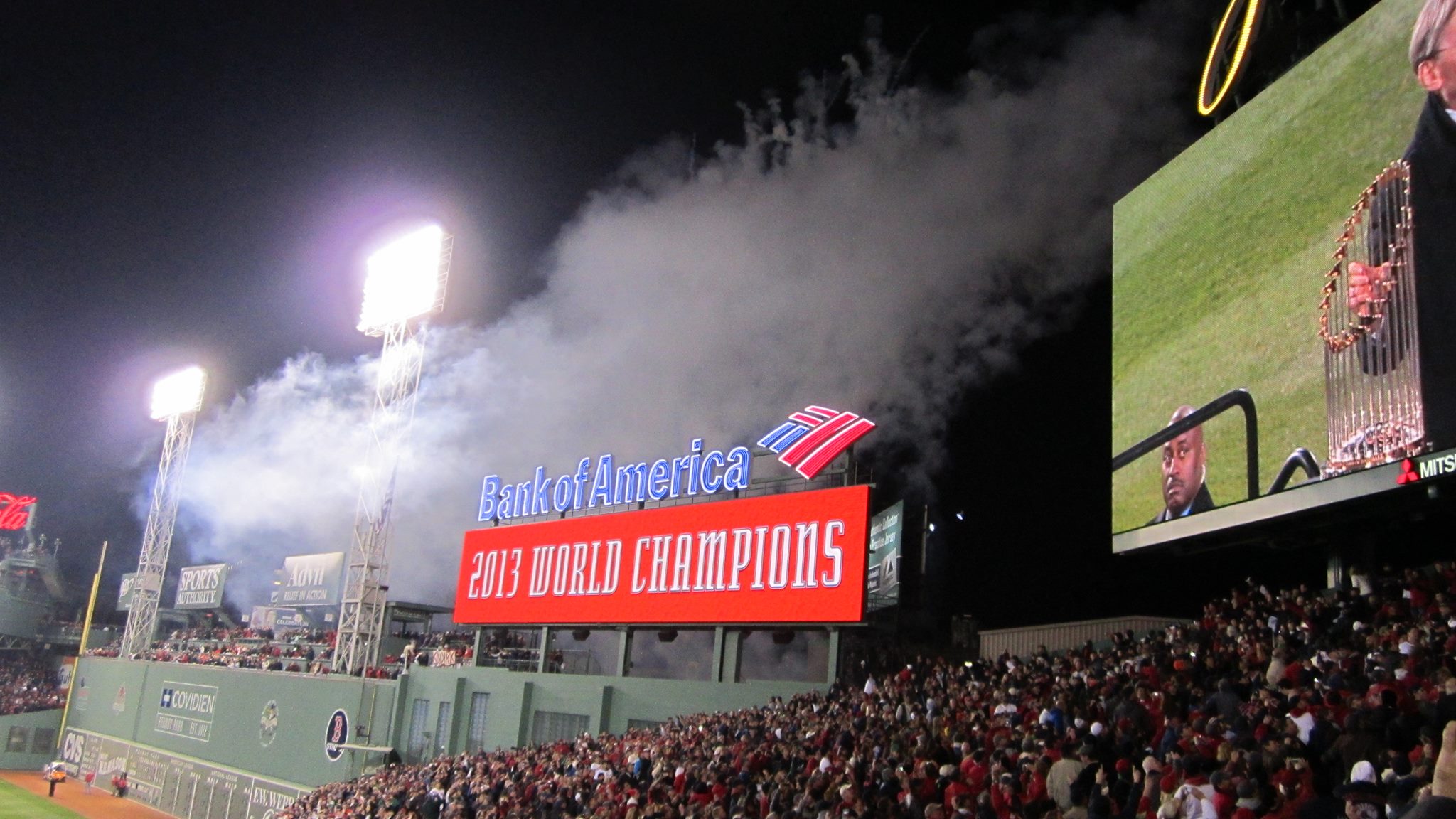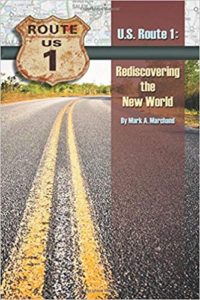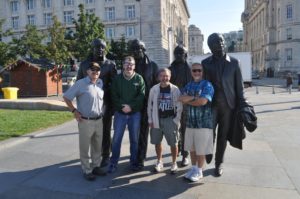They Built Them; I Came
Major league baseball stadiums are like time capsules — living time capsules that preserve the game Americans have loved since the mid 19th century.
Within stadium walls, dazzling plays come to pass, the sometimes plodding nine-inning script proceeds without time constraints, fans cheer, fans boo, beer and peanuts are consumed, one team wins, and one loses. All of this and more occurs without any thought to the world outside. Time capsules, after all, maintain things as they are for future generations to see. And with some exceptions, spectators today witness the same pitches, the same hits, and the same fielding plays that took place since baseball’s birth two centuries ago.
Out there, meanwhile, wars continue, traffic creeps by, people live and die, jets soar overhead, money is made and lost, and the struggle of life carries on.
The fan who nestles into his or her ballpark seat for about three hours expects to be transported into the more magical, timeless world that author W.P. Kinsella painted for us. Kinsella, who passed away late last year, wrote the book Shoeless Joe, upon which the popular movie Field of Dreams was based. He had a knack for capturing the essence of this simple game, the arenas in which it’s played, and the game’s relevance to our lives. His tale of creating a lush, green ball field out of an Iowa cornfield brings to life the feelings many baseball fans harbor for their beloved diamonds and the enclosures in which the game is witnessed. There might be economic turmoil and a cruel world out there in Iowa. But cross the foul line, in Kinsella’s case, and you’re protected as a warm sense of the contest and sentinel-like lights surround you. Perhaps, as he writes, memories of old games and long-lost relatives will arise, and maybe even the ghost of a famous player will wander in from the outfield.
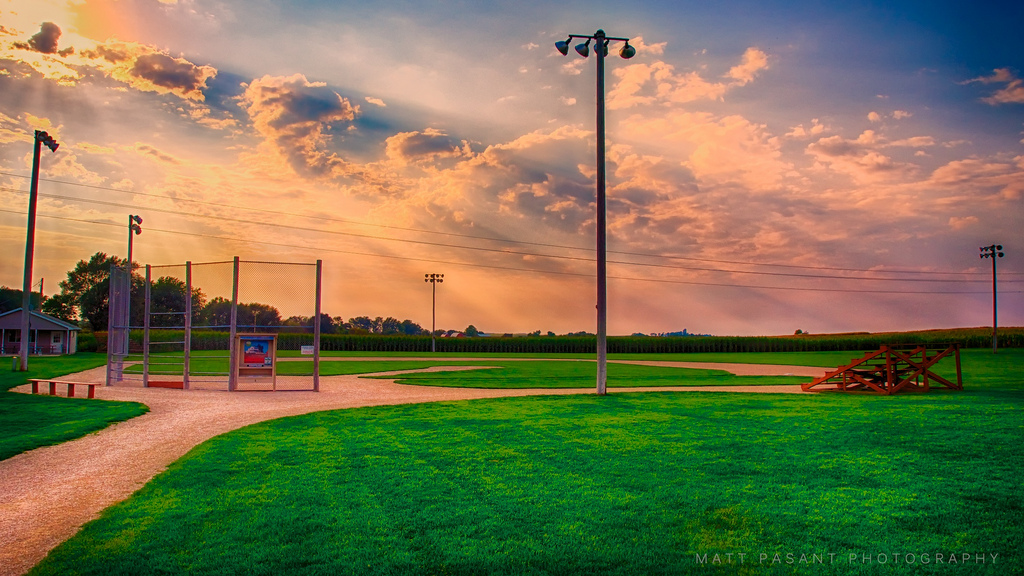 The Iowa cornfield/baseball field from “Field of Dreams
The Iowa cornfield/baseball field from “Field of Dreams
These ballparks come in all shapes and sizes. We watch our games in venues ranging from the cramped wooden or plastic seats in Fenway Park in Boston, to cushy, spacious seats in newer stadiums like PNC in Pittsburgh. Thankfully, many of the newer parks have been built as part of professional baseball’s “retro” phase, during which the design of many new parks harkens back to the shapes and feel of mid-20th century venues.
Almost without exception, major league ballparks remain in the downtown areas of cities. The 1970s-80s trend to move some sports venues out of congested cityscapes to the wide-open suburbs is just wrong. If you’re the Cubs, you play in the city of Chicago. Don’t use the city in your team’s name and abandon it for shopping mall-laden suburban America.
Since seeing my first major league contest in 1968 at Fenway, I have maintained a steady love of the game. I have expanded my fandom to include studying and, eventually, visiting as many ballparks as I can. Armed with a private pilot’s license and a career that had me traveling to cities around the nation (if my former boss is reading this, hey you didn’t expect me to just sit in my hotel at night?) I have so far visited 18 of 30 ballparks. Of those 18, only 16 remain active. Olympic Stadium in Montreal is no longer used by the Expos. They’re now in Washington, D.C. and are known as The Nationals. The Seattle Kingdome was imploded in 2000 to make room for a new football stadium. The Mariners of baseball moved to new Safeco Field up the road.
Here are some observations and reflections on the ballparks I have visited:
Fenway Park (Boston, Red Sox) — Five words come to mind when I think of Fenway, where I’ve co-owned weekend season tickets since 1988: asymmetrical, green, historic, cramped, and beautiful. If famed sports broadcaster Keith Jackson were crafting this piece with me, he’d describe Fenway with his Rose Bowl phrase: “the grand daddy of ’em all.” Fenway Park in the Back Bay neighborhood of Boston is, after all, the oldest baseball park in the nation. It’s also the smallest. Fenway opened in 1912, the same week the Titanic sunk in the North Atlantic. Some might say that timing portended the decades of tragedy and failure for which the Red Sox were known. Maybe so, but the Red Sox finally won a World Series title in 2004, ending an 86-year drought.
Fenway was designed to fit into a dense residential-commercial setting, which led to its odd layout. Left field is hemmed in by a 37-foot wall (aka the “Green Monster” and THE most historic, manually operated scoreboard in baseball), while right field ends in bleacher and grandstand seats. The foul pole at the famous left field wall is only 310 feet away from home plate. The right field foul pole is 302 feet away from home, but the short wall there curves quickly to 380 feet away from home, near where the bullpens start. And for good measure, the farthest reach of center field in an uneven triangle is 420 feet away from home — a tough challenge for even the best hitters in baseball.
Looking down at Fenway from above and from north to south, the lower left resembles half of a square. The remaining boundaries are made up of four different lines with nary a right angle to be found. Five neighborhood roads form the irregular shape: Yawkey Way, Brookline Avenue, Lansdowne Street, Ipswich Street, and Van Ness Street.

An older aerial view of Fenway Park
I could wax on, but there are other ballparks to discuss. Fenway, though, has drawn attention from many writers who have taken descriptions of this 103-year-old baseball monument on a more poetic excursion. Take John Updike in 1960 in the New Yorker magazine:
“Fenway Park is a little lyrical bandbox of a ballpark. Everything is painted green and seems in curiously sharp focus like the inside of an old-fashioned Easter Egg. It was built in 1912 and rebuilt in 1934 and offers, as do most Boston artifacts, a compromise between man’s Euclidean determinations and nature’s beguiling irregularities.”
I described my feelings about the place in 2012, when Fenway turned 100. This is a column I wrote for The Republican daily newspaper in Springfield, Mass.
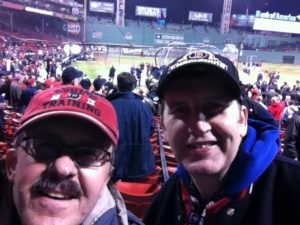
With friend Joe Lahiff after watching the Red Sox win the World Series in Game 6 of the 2013 World Series at Fenway Park
Yankee Stadium (New York City, Yankees) — Home to the dreaded Red Sox rivals, Yankee Stadium joins Fenway as perhaps the two most famous and historic stadiums in all of baseball. The venue where the Yankees play today isn’t the original that Babe Ruth built. A new one opened in 2009, a few hundred yards from the original — but the owners retained or enhanced many of the famous architectural features from the 1923 version. The best known is the facade lining the top of the inside wall.
Aside from my feelings about our rivals, I’ve always liked Yankee Stadium for three reasons. First, it sits in the heart of New York City’s densely populated borough, The Bronx. The swamps of New Jersey might have lured the Jets and Giants of football, but the Yankees are right at home at 161st Street in The Bronx. Second, it’s huge. The capacity is down a bit to 50,000 from the 56,000 that could occupy the original. But there’s a “wow” factor when you enter. The noise, the vendors hawking food and drink, the sheer quantity of people, and massive electronic scoreboards overwhelm the first-time visitor. Finally, while diminutive Fenway has only one or two decks in places, Yankee Stadium soars upward with up to four decks. I once bought a seat in the highest deck. It took my friends and me a full 20 minutes to reach the rarefied air via a series of sloping ramps.![]()
Oriole Park at Camden Yards (Baltimore, Orioles) — Next to Fenway and Yankee Stadium, this is my favorite baseball arena. Opened in 1992, the dazzling, green structure sparked a revival in constructing new baseball stadiums that mimic older, classic ballparks, ranging from Fenway to the long-gone Ebbets Field in Brooklyn. For most baseball fans like me, Camden Yards put an end to the boring, downright ugly circular fields that dotted the baseball landscape in the 1970s — including those in Cincinnati, Pittsburgh, and Philadelphia. All three and many others have since been demolished and replaced with warmer, friendly “retro” parks that remind us of baseball’s halcyon days.
Like Fenway, Camden Yards was designed to fit into a tight downtown district. While the outfield layout is more symmetrical than Fenway’s, right field is hemmed in by tall, refurbished brick warehouses and a small section of bleacher seats. Centerfield ends in a collection of bushes and a dark background for hitters. Three decks of grandstand seats rise behind left field.
I’ve walked the entire ballpark and I defy anyone to find a seat with a bad view. The designers did their homework. The food options are great. I first visited on a Sunday in 2000 and for $100 I bought a seat in the first row behind home plate. The ticket also included lunch at the Boog Powell (a famous Oriole first baseman) restaurant behind right field, and access to the private clubs and their tall, cool drinks in the second deck above home. I usually don’t spend that much for a ticket, but it seemed like a bargain to me.
And of course Camden Yards is downtown, and easily reachable via an above-ground light-rail system that connects to the Baltimore-Washington International Airport, about 10 miles away. I know many Albany-area Red Sox and Yankee fans who find a cheap ticket on Southwest Airlines to see their teams play in Baltimore. This often creates resentment among Oriole fans, who find themselves out-cheered by fans from visiting teams. But the experience is too good for us out-of-towners to resist.
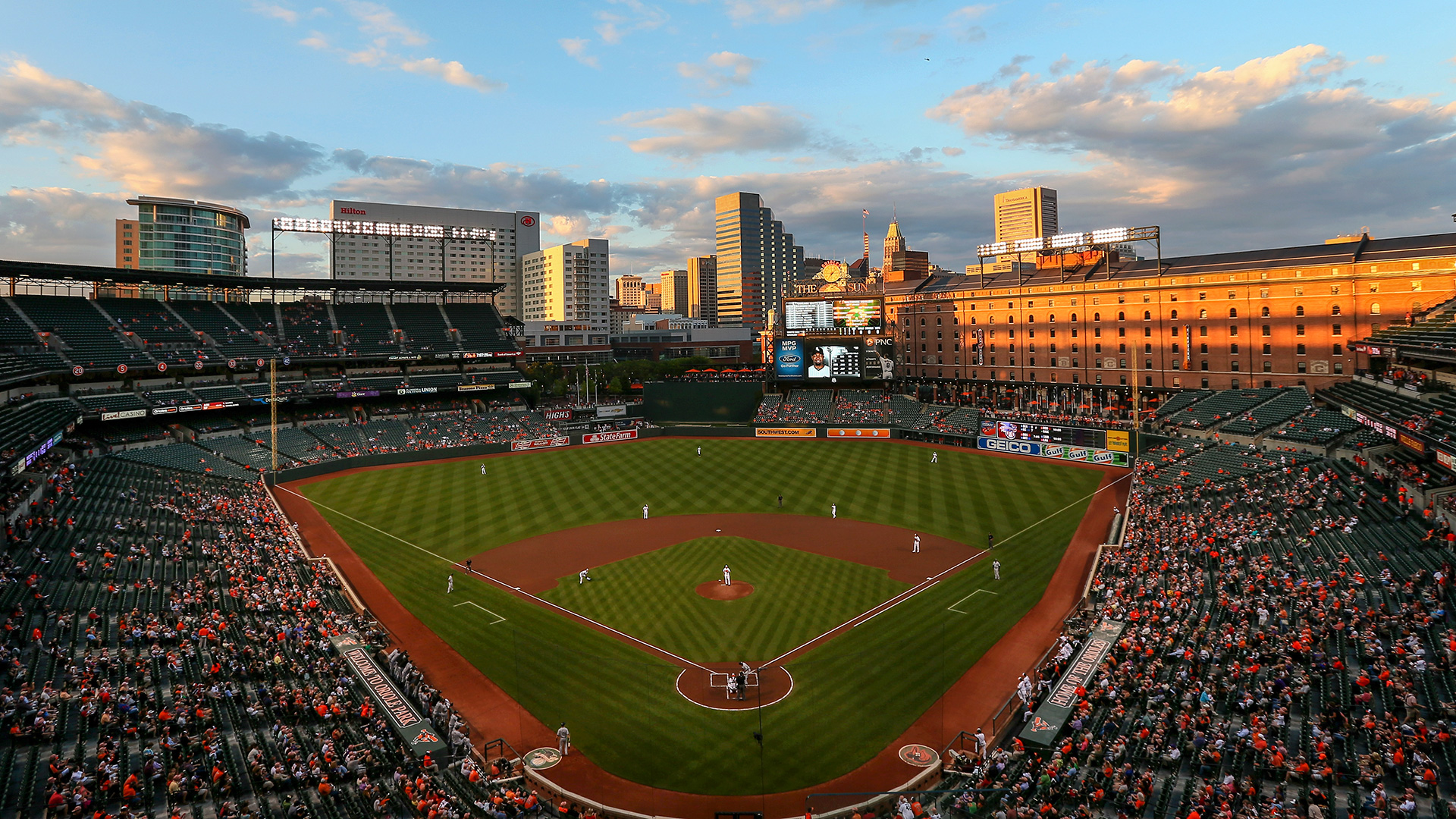 Camden Yards
Camden Yards
Tropicana Field (St. Petersburg, Fla., Rays) — I strive for balance when I write, so I have to mention one of the most terrible fan experiences. Quite simply put, this is the worst place in America to see professional baseball. The Tampa Bay Rays play in what is easily the ugliest, architecturally speaking, venue in Major League Baseball. Watching a game there, as I have done twice, is like visiting a mausoleum. No one has ever satisfactorily answered this question for me: Why build an enclosed stadium with a non-retractable dome in Florida? A co-worker once told me it was because Tampa experiences more lightning strikes than almost anywhere else in the U.S. Perhaps, but the last time I checked, Florida called itself, “The Sunshine State.”
In addition to a tilted roof ringed with a series of catwalks inside — a feature that requires special ground rules because some fly balls and pop-ups hit those walks — the blotchy, puke-green artificial turf looks like it’s been around for 100 years and suffered from hundreds of chemical spills. Don’t adjust your TV set when you see a game being played here. The picture you see is real.
The sound is bad, the parking is tight, and the lighting can give you a headache. I pity the poor Rays. They seldom sell out the place, even on the rare occasions when they’ve made the playoffs since the field opened in 1990. Team owners have made several attempts to build a new stadium. It hasn’t happened.
The most fan-friendly feature at Tropicana is the 10,000-gallon tank in center field, where ticket-holders can pet and feed one of 30 devil-ray-like fish called cownose rays.
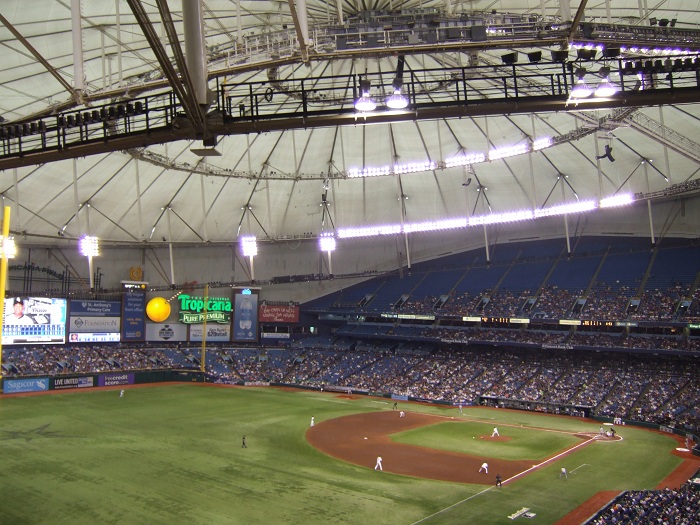 Tropicana Field
Tropicana Field
Rogers Centre (Toronto, Blue Jays) — Speaking of domes, don’t pass up an opportunity to see a game here. Located in downtown Toronto and originally known as The Skydome, this indoor baseball stadium has a retractable roof! I know it costs a lot more to engineer and build a roof that opens and closes, but what a concept: If the weather’s nice (Canada north of the border can be beautiful) open the dome. Fans can bask in sunlight and warm air, while gazing at the downtown skyline that surrounds the field. This includes the majestic Space Needle-like CN Tower that pokes about 1,500 feet into the sky next door. If it rains, the Blue Jays close the roof. Rain checks are not needed here.
The stadium itself is a little ordinary, and the games are played on artificial turf. There are three decks that rise from the field on all sides, except for the outfield. There are some seats in center, but that area is ringed in by a large video scoreboard and a complex of glassed-in restaurants and hotel rooms. You can eat or just hang out in your room while watching a game. This did create some buzz a few years after the structure opened in 1989. On three occasions, young couples in one of the outfield hotel rooms forgot to close their curtains during romantic encounters.
Wrigley Field (Chicago, Cubs) — I’ve been here twice during work trips and I have to mention it because the Cubs finally won a World Series last year. It’s the second-oldest ballpark in the country, behind Fenway. Wrigley suffers from some of the same issues as Fenway. It can be cramped and many of the seats are uncomfortable. But it’s also located in a mostly residential neighborhood, with lots of bars.
And then there’s the layer of climbing ivy vines on the walls that enclose the outfield. Baseball fans must see this unusual ballpark feature once in their lives. There is nothing else like it. It can create some unusual plays, such as when the batted ball gets stuck in the ivy. There are special ground rules that apply in that situation. In most cases, instead of the outfielder fishing the ball out of the vegetation while the runner circles the bases, the runner is awarded a ground-rule double. What many don’t know is that behind the layer of ivy is a solid brick wall. Many an outfielder bounding after the ball has suffered a near or full concussion after bone-crushing collisions with the wall — after expecting a soft landing in the brush.
The rest — In no particular order, I also visited and watched games at: Turner Field in Atlanta (which is being closed next year in a controversial move to a suburban, publicly funded new stadium), Cromerica Park in Detroit, Progressive Field in Cleveland, U.S. Cellular Field on the South Side of Chicago where the White Sox play (and soon to have a new corporate name, Guaranteed Rate Field), Citizens Bank Park in Philadelphia, PNC Park in Pittsburgh, Miller Park in Milwaukee, Target Field in Minneapolis, Globe Life Park in Arlington, Texas, and Citi Field where the Mets play in Queens, New York. I highly recommend all of them, especially the retractable dome field in Milwaukee.
They built it; I came — with a tip of the hat to Kinsella for his great line in Shoeless Joe. At least 12 other ballparks await.

